Today I’m working on Soñando en Español – my 3-movement concerto for harp and orchestra. I’m meeting with Elise Hemke, the harpist who’ll play it, via Skype tonight. She’s the first harpist besides me to ever play it and there’s a problem:
I improvise a lot of the piece when I play it, something I can’t expect other harp soloists to do. Every note and subtlety is written out for all the other instruments in the orchestra, but the harp part has big areas where I’ve notated only chords and slashes in the music, which tells me what to do, but gives her no clue.
So we need to pull together a part for her so she knows what music to learn.
If you’ve read my “Building a Box out of Fog” blog – you know I recently went through a similar process from the other side, where I was the one in her shoes – so I deeply empathize with what it’s like to be given ‘music’ that doesn’t tell you what you actually need to play. Now it’s my responsibility, as the composer, to make that absolutely clear.
At least 90% of her part is written out but then there are pages like this, where it trails off and disappears …
So my first job is to cut and paste these together and then try to start filling in the missing parts. We also need to make it legible. I personally hate page turns, so the parts I do write out, I like to cram it into the smallest space possible. It looks like I’m trying to make it into a secret, illegible code. But I’m not.
DIGRESSION: As I wrote this, I just fantasized about a device that we put on Elise’s head and my head, with an electric coil between us. Then I vividly imagine the entire piece and it goes into her head, so I never have to write it down.
But, unfortunately, I’ve seen “The Fly” and I know she wouldn’t just get the piece, she’d also get my childhood obsession with cows and my existential night terrors so … OK, now I reconciled to actually getting it all written out.
On my team, Noah, my music copyist in Oregon, is ready to help put it all together – and the goal, at today’s end, is to have a part for this piece with all the notes in it, so that Elise has a part she can learn. But I think Noah’s still asleep – he’s just been through a bunch of long days so I know he won’t be up early – and he’s 3 hours behind me on the West Coast.
9:18 AM — Yowza!!! I just discovered that Catie, a transcriptionist Elise hired to help her transcribe some of what I played in the debut of this piece, has transcribed more than I thought!
9:30 AM Oops .. the files arrive in Sibelius format and I use Finale music software.
10:11 AM Aha! She’s has a friend who can translate them to Finale.
10:30 AM I have to stop work for an interview with the historian from the Museum of Making Music. And lunch.
12:55 PM I’ve printed out my incomplete files and Catie’s transcriptions. Here’s what they look like sitting on the livingroom floor where I’m about to cut-and-paste them together. I printed hers on yellow so that when they’re all taped together, I’ll still be easily able to tell hers from mine and Noah (if he ever wakes up) will more easily be able to consolidate them.
2:02 PM EST Noah’s awake! I just told him to come read this blog so he can find out what we’re doing today.
3:30 PM EST: I’ve just sent Noah “Finale” files of Elise’s part for the middle movement, “Merceditas,” Catie’s transcription of the cadenza and a PDF of the score so he can check Elise’s part against it. While he’s consolidating those, I’ll be working on filling in some of the holes in the first movement.
4:46 PM EST: I just delayed the meeting with Elise ’til Saturday – it’ll take longer than 3 hours to pull these files together and our meeting will be much more productive if we’re looking at completed manuscripts.
So, sadly for Elise, that gives me room to recompose, the thing every performer wishes every composer would stop doing to their pieces. But, honestly, this will make it way better and easier to play … I promise.
6:17 PM EST: I just finished writing the new intro — it’s what I wish I’d played in the premiere. It echos the stroke of midnight that – in the story – begins the music, and it lets the harpist play over the whole instrument – so she can have that last moment of warm-up before the piece begins.
7:16 PM EST: My brain hurts.
8:28 PM EST: Noah is now hard at work, I’m off to a meeting and I’ve started working on the “solo” section, getting a written-out version of what I improvised in concert – only now I get to write it the way I wish I’d played it! I’m starting to see the benefit in writing music down…
10:57 PM EST: I’m throwing in the towel for tonight. I got two more sections written, Noah got the cadenzas integrated into the score of “Merceditas” and “My Mother’s Mexican Hat” (Movements 2 & 1) and I’ve started working on the harp ‘solo’ in Mvt 1. We haven’t achieved complete legibility of the whole thing, but now it looks more like this:
FRI. JAN. 4, 2013
12:00 PM EST: I just got to my studio, and discovered Noah had added the updated first movement to our shared Dropbox folder. This means we’ve moved from ‘consolidating’ different versions of the part, to having a SINGLE part.
He also sent me a list of questions I need to answer in order for him to take the next steps.
And what I’ll do right now is check the part he sent against the questions and make a list of answers … and of my next steps: the ‘holes’ in the piece I need to fill with music notation.
What he sent is starting to look like real music, though there’s still a lot to add (slurs, fingerings) and more cleanup – but we’ve definitely made progress! And that feels good.
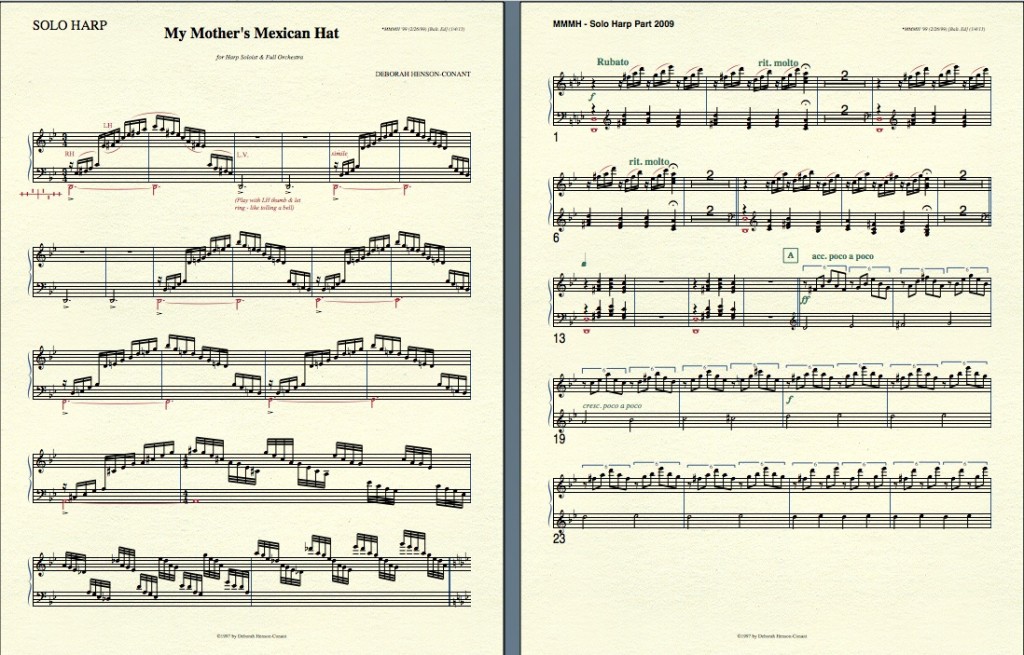 8:03 PM EST: We’ve now got the parts ‘looking’ pretty good, but are discovering other problems on the back end. You’ll see what I mean, further down the page.
8:03 PM EST: We’ve now got the parts ‘looking’ pretty good, but are discovering other problems on the back end. You’ll see what I mean, further down the page.
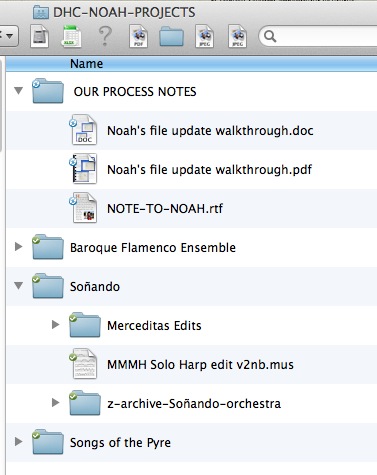 We’re using Dropbox to network our computers, and we’re at the point right now that we’re essentially passing the files back and forth, and each working on them – me in Boston and Noah in Eugene, Oregon.
We’re using Dropbox to network our computers, and we’re at the point right now that we’re essentially passing the files back and forth, and each working on them – me in Boston and Noah in Eugene, Oregon.
Each time one of us takes over, we copy the file, give it a new version number and add our initials to the end – so we can’t accidentally screw up the other’s work, and we can always go back one version if something bad happens.
Once we’ve copied and renamed the file, we take the old version and put it in the “z-archives” file (we use “z” at the beginning of the word just because that then shoves that archive folder down below our working folders). At right you can see what our joint project folder looks like, and the other two projects we’re working on in addition to “Soñando en Español.”
Here (below) you can see us discussing one of the ‘backend’ problems we’re having. What you see here is the note I left for Noah on version 3 of the file, explaining that I need him to fix a problem I created by setting up the file a certain way years ago when I started the project:
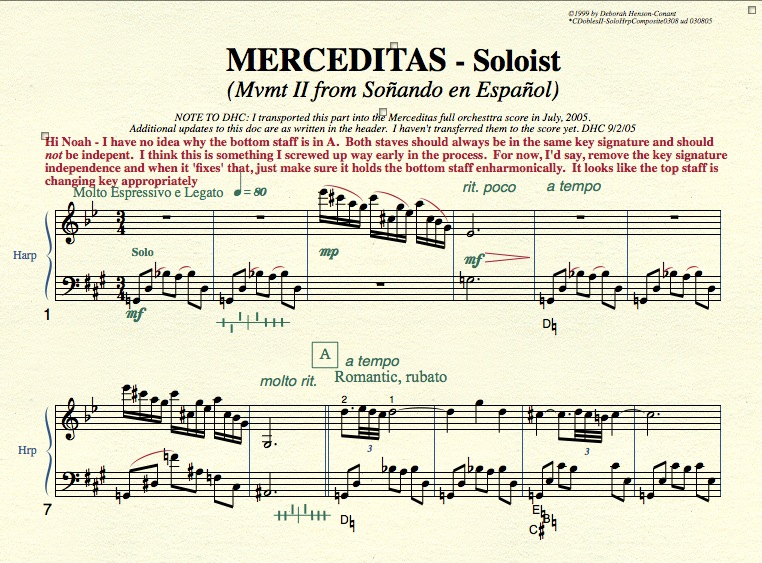 Sat. Jan. 5, 2013
Sat. Jan. 5, 2013
Noah finished all the rough edits last night. I still have parts to finish composing – meaning, “make decisions on what exact notes to play where” – and I define that here because the advantage of improvising is that you don’t need to make that decision when you create the piece. You just outline the harmony. Then you make the specific note decisions in the moment when you’re playing. They’re not always the best note decisions, but they’re responsive to what’s going on at the moment.
On some level, at least for me, improvising is a form of decision-avoidance. But that’s for a therapy session.
At the moment I need to just hunker down and decide what Elise will play when and where. Or, in some cases, I just need to notate the decisions that have evolved over time – the notes I’ve discovered I want, the notes that are now ‘obvious’ to me … but invisible to her. Because they’re in my head.
But – and here’s the hard part for me: they’re not in my head as ‘notes.’ I can’t just look into my head and say, “Ah, great, I’ll just write that down.” They’re in my head as gestures of sound – sometimes highly specific gestures of sound that other people would describe as a series of notes. They just don’t look like notes to me. So, for me, it’s a painstaking process to translate them from emotional/musical gestures to notes-on-a-page.
Sometimes I have to actually say the notes out-loud to myself to make that cognitive translation from whatever gestural-musical-thing the piece is to me into the concrete map that the player will use to recreate a musical journey for the audience.
The notes are a lingua-franca, a code – the thing Elise will use to translate those notes back into musical/emotional gestures and speak them with her own hands.
And yes, I am avoiding actually going to the instrument to do this by exploring my process.
Sigh … so shoot me.
10:30 AM: In any case, here’s what I’m doing now: taking each page of the manuscript to the harp, playing it note-for-note and marking in the changes in red. Then I climb up to my studio and input those changes to the manuscript on my computer. As I complete an edit, I “blue it out” – meaning, I highlight it with my blue marker, so if I get confused, I’ll know what I have and haven’t input yet.
2:00 pm: Elise and I just met over the internet, using a platform called Anymeeting.com that I use for the live video chats on my online course. This is what it looked like on my screen: 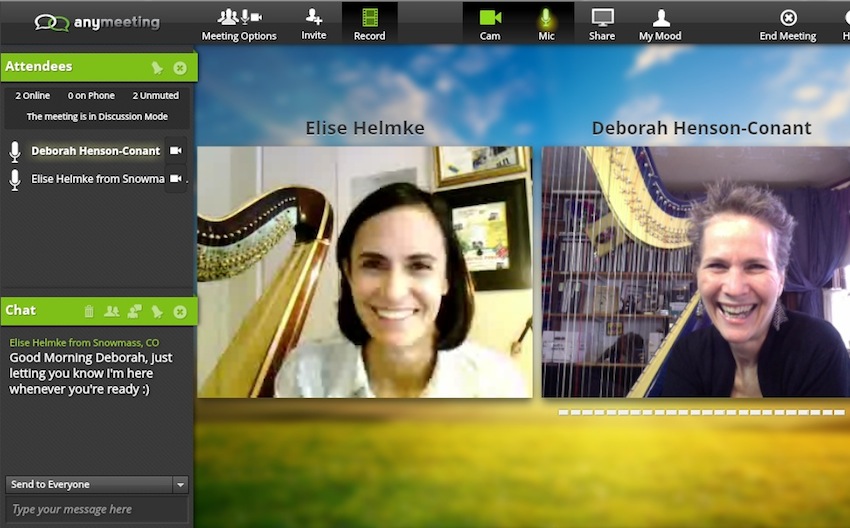 We talked about the piece, about the parts that are missing, the timeline for my getting her the missing notes and when we’ll meet again online. And I listened to her play the final movement of the piece.
We talked about the piece, about the parts that are missing, the timeline for my getting her the missing notes and when we’ll meet again online. And I listened to her play the final movement of the piece.
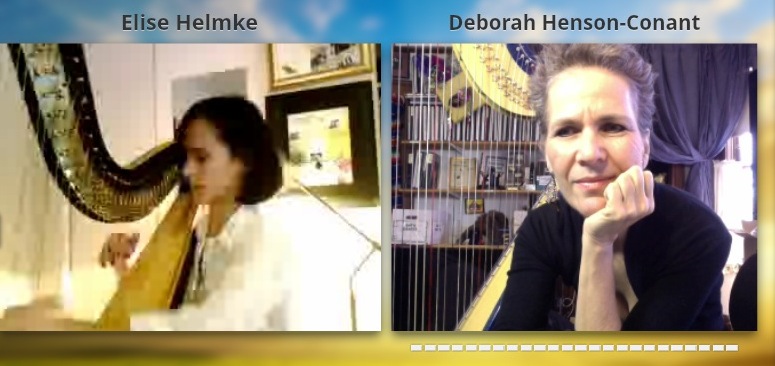 Hearing someone else play my melodies is deeply moving – and I could hear her musicality even when she was just reading the new sections I’d sent this morning, and reading them from her computer screen where she had to scroll down to see each new line. But it was all there. 2000 miles away and I could hear the music.
Hearing someone else play my melodies is deeply moving – and I could hear her musicality even when she was just reading the new sections I’d sent this morning, and reading them from her computer screen where she had to scroll down to see each new line. But it was all there. 2000 miles away and I could hear the music.
Then she played the final movement which almost blew out the sound control on my computer. Ha! Yes! It’s that passionate. I thought: She is going to give an incredible performance of this!
11:50 PM I’ve been working most of the day on the harp part. For me it goes so slow, writing for harp. The other instruments are by-and-large a single line, but the harp is so complex, a combination of melody, harmony, and intricate interplay. And so many notes.
In any case, I set up a studio space with a concert harp, computer, keyboard and music-stands – this shortens the distance – literally – between working the music out on the harp and translating it onto keyboard and into the music manuscript. Also, I put it by the radiator, which keeps my feet warm.
And by day’s end, I’ve probably finished half of what I need to. Here’s picture of the little harp-transcribing studio I set up.
Tue. Jan. 8, 2013
Hi – it’s Bea, Deborah’s assistant. Deborah has been working around the clock on this project. Today, I heard her playing in the studio and sneaked in to listen. Well, she discovered me and let me take some video as she worked through a part of the composition. Here’s a short clip!
Sat. Jan 12, 2013
Noah and I have been passing the files back and forth, as I’ve been adding notes and he’s been cleaning up my work. I got a little waylaid the past two days because of another project (my online course is going live on Monday and James and I have been updating the course website and having fun adding forums and other new functionality) … ahem … so this morning I’m committed to finishing the composition part, then handing it over to Noah to clean up.
I’m trying to just get the notes in the fastest way I can and then use shorthand or notes that I write right on the scores to tell Noah what I ‘mean’ – here’s an example of the kind of notes he gets from me:
I use his name every time I write a note to him because otherwise he might think I intend these as notes to the player. I mean, he’d be able to ‘figure out’ that they weren’t, but I like to avoid making people ‘figure stuff out’ that I could make explicit in the first place.
Ha! I just heard myself say that and realize that this whole project is about that! The original manuscript I gave Elise would have forced her to figure out way more than is realistic. In some places it was really just an embellished composer’s sketch.
Now Noah and I are turning it into a playable manuscript. Which can be amazingly tedious — at the same time that it’s exciting, because I realize it empowers the player and makes the music independent — meaning, I no longer have to go with the music to help it cross the street.
It feels like climbing a mountain – strenuous, sometimes painful, even boring as you’re making the climb, but exhilarating in those moments when you turn around and realize how much more you can see, how far you’ve made it.
1:00 pm:
Since I normally play this piece by ear, I use study-audio to help remind me what the orchestra is playing. I have an audio file of the piece without the harp part, and as I listen, I play along with it on my harp. Sometimes I record what I’m playing – and sometimes that just reminds me what I do in that section of the music.
That’s how I figure out what I need to write for her to play. Here’s what the interface looks like. This is in a program called “Digital Performer” – the red line is the audio file, and on the right, the letters of the alphabet refer to the Rehearsal Letters in the score. They allow me to jump to the part of the piece that I want to work on. What I realized yesterday is that, when I write for an instrument that I can play, I think with my hands. That’s part of why the process of translating that to written notes feels awkward for me – but also why I’m lucky to have tools like Digital Performer, Finale — and even just video and audio files, so I can work in ways that work for me as a performing-composer and with Noah, as a team.
What I realized yesterday is that, when I write for an instrument that I can play, I think with my hands. That’s part of why the process of translating that to written notes feels awkward for me – but also why I’m lucky to have tools like Digital Performer, Finale — and even just video and audio files, so I can work in ways that work for me as a performing-composer and with Noah, as a team.
2:06 PM:
This is a perfect example of why it’s so hard to write out music for harp. I spent the last hour trying to figure out how to notate something that’s very coloristic and gestural, the kind of thing that only a harp can do. You’ll see my attempt to write it and my explanation to Noah of what I’m trying to notate, so he can either tell me that what I wrote will work or not.
 One thing that my notation doesn’t make clear is what beats these things happen on and the changeover from a right-hand gliss to a left-hand gliss. There should be names for these things — maybe there are and I don’t know them because I didn’t learn harp in the standard curriculum.
One thing that my notation doesn’t make clear is what beats these things happen on and the changeover from a right-hand gliss to a left-hand gliss. There should be names for these things — maybe there are and I don’t know them because I didn’t learn harp in the standard curriculum.
It occurs to me sometimes, that, in writing out my compositions, it’s kind of like leaving detailed notes for what you want people to do with your most treasured books after you die.
Not exactly, but kind of.
Sun. Jan. 13, 2013
Noah sent me 3 possible ways we could notate the “Crazy Q Section”:
And included a “Glissertation” on the pros and cons of each way:
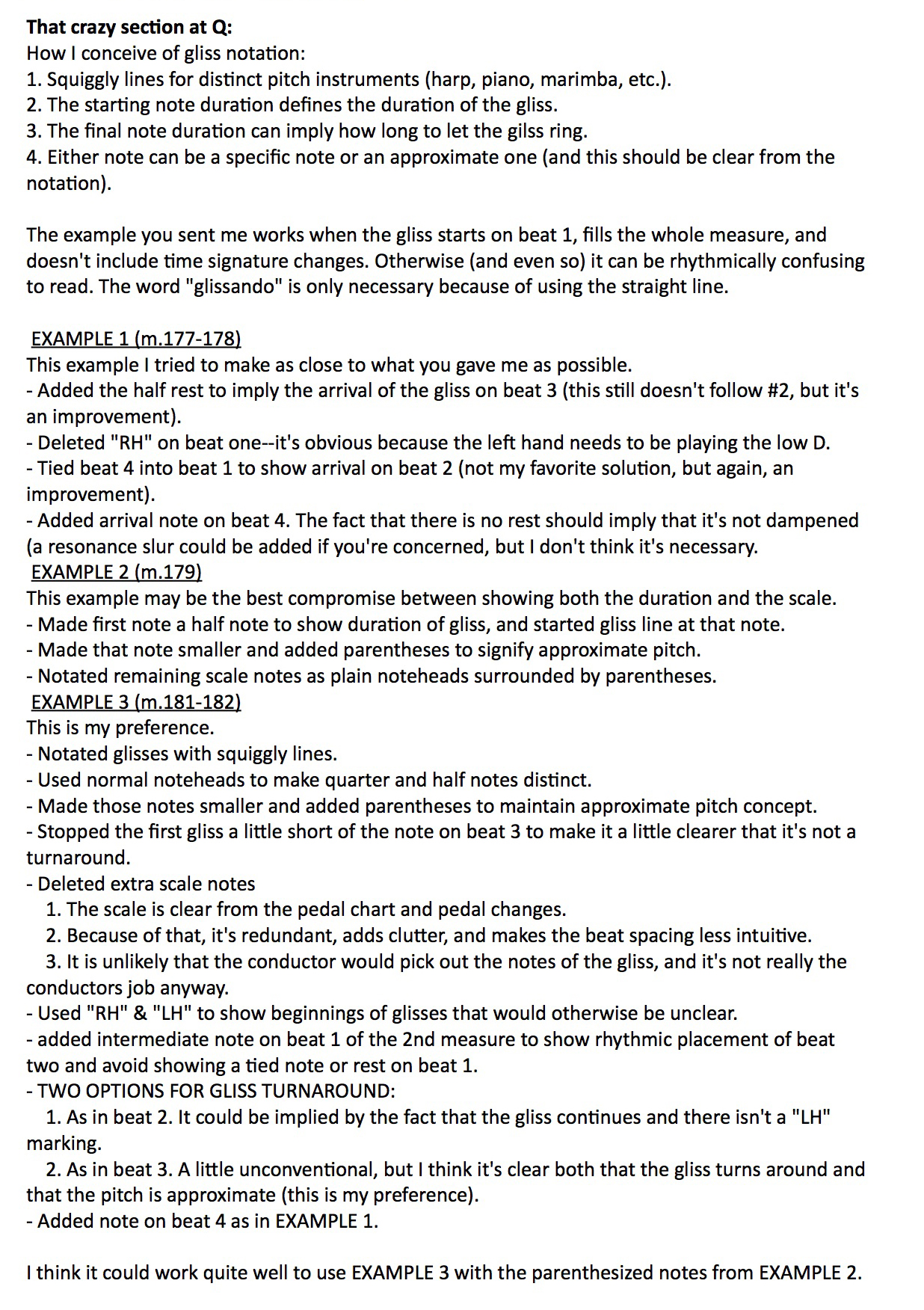 We disagreed about how important it is to include the scale notes, which was exciting, because it’s not that often I find myself with a strong opinion about music notation that I can support, and it’s always fun to experience how passionate Noah is about creating the most comprehensible, intuitive and poetic written translation of music that he can.
We disagreed about how important it is to include the scale notes, which was exciting, because it’s not that often I find myself with a strong opinion about music notation that I can support, and it’s always fun to experience how passionate Noah is about creating the most comprehensible, intuitive and poetic written translation of music that he can.
In the end, my trump card was that, even though I play the harp and I wrote the music, I would personally not be able to easily figure out what notes the harp was playing without the written-out scale.
Mon. Jan. 14, 2013
All the notes are now written, Noah’s cleaned up the first movement, and I’m about to do the task I’ve been avoiding: proof-read the middle movement. This means I actually have to read my own music, which means I have to turn off the part of my brain that knows how to play it and actually play what’s written.
It also means I have to tune my harp … sigh …
Fortunately, I earlier today stumbled upon the container of candy left over from my “Homecoming Show” VIP reception last month.
I’ve fortified myself with chocolate.
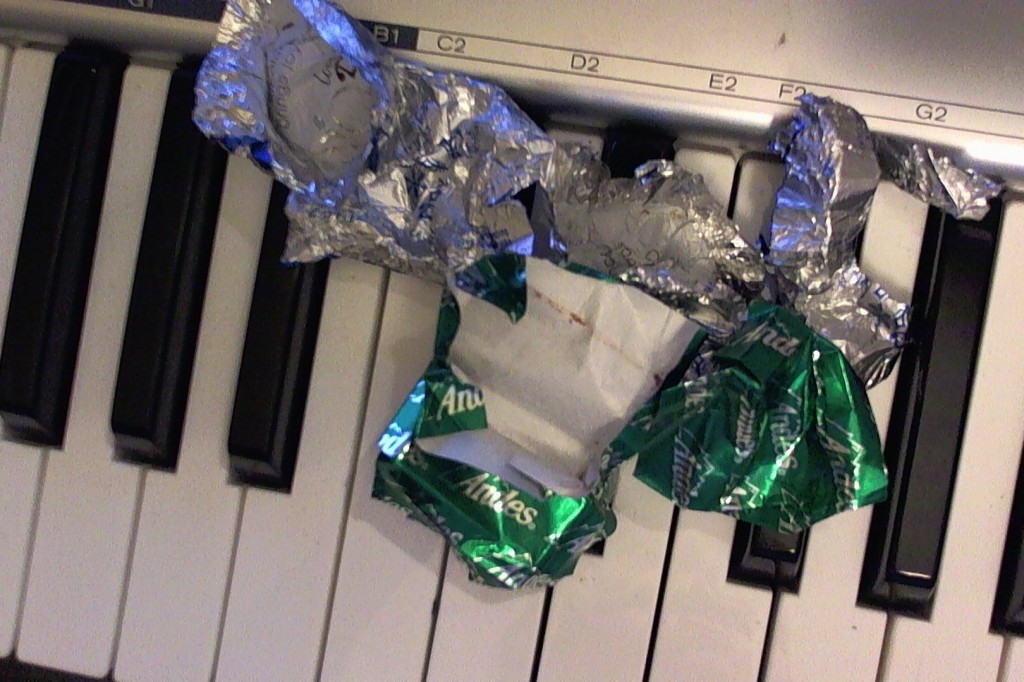 Fri. Jan. 18th
Fri. Jan. 18th
I’ve done one detailed proofing of Merceditas – although I need to go back and proof-read it again, and then work on the interludes between the three movements of the concerto. To recompose them I watched the video of my last performance, and created an outline I can follow when I sit down to write it out.
Tonight, my goal was to create a video of one of the strumming sections in the first movement. Even though the section is fully notated, it uses techniques that defy standard music notation.
This was the closest we could come to writing out the notes (this is just the last few measures), and you’ll see that, even though it’s all written out, as the composer, I still need to explain to players what I mean by this notation:
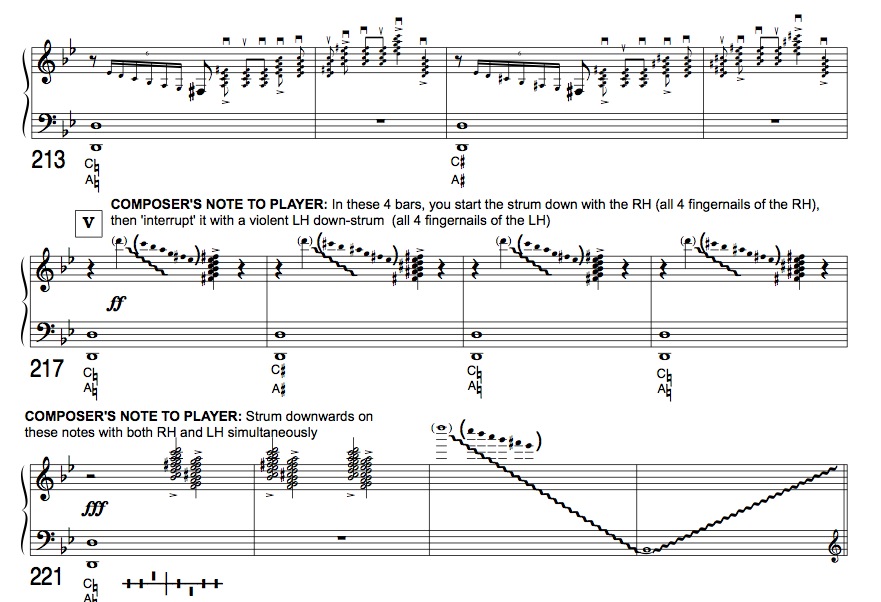 So this video shows what I mean … although I’m beginning to think I may need to create a slower version.
So this video shows what I mean … although I’m beginning to think I may need to create a slower version.
I’ll try to keep updating this blog as we work on the piece… but I might forget…

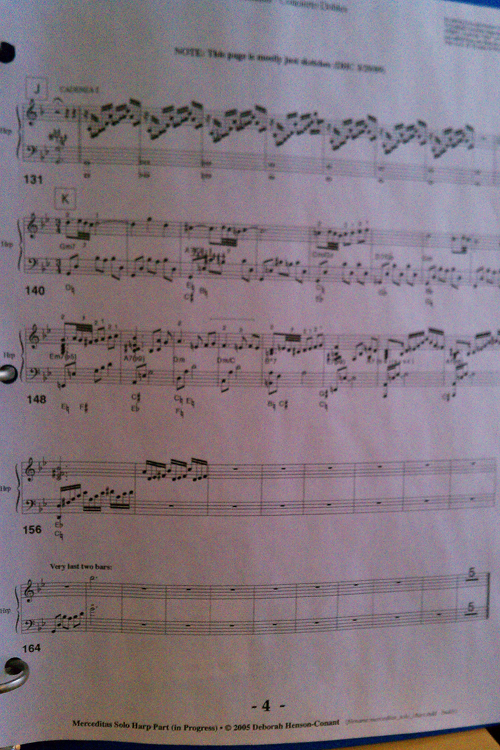
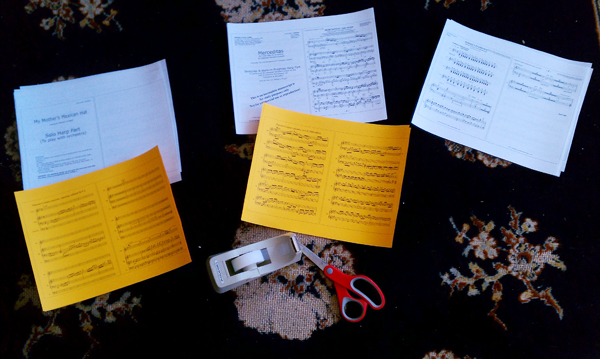
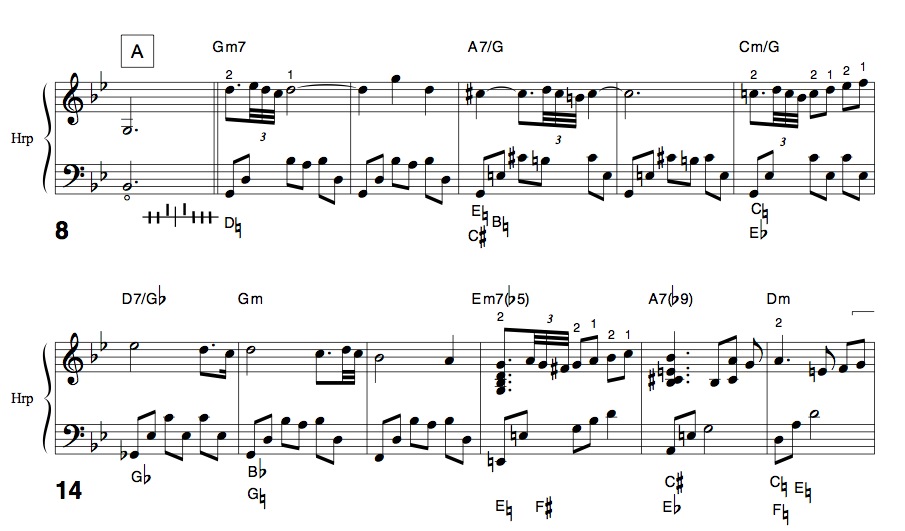
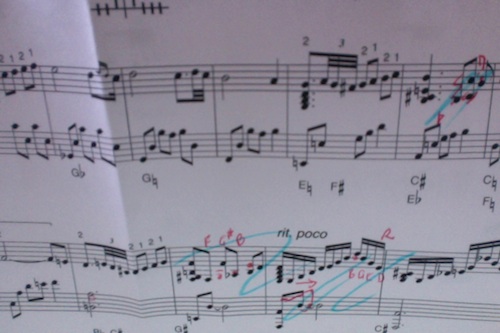
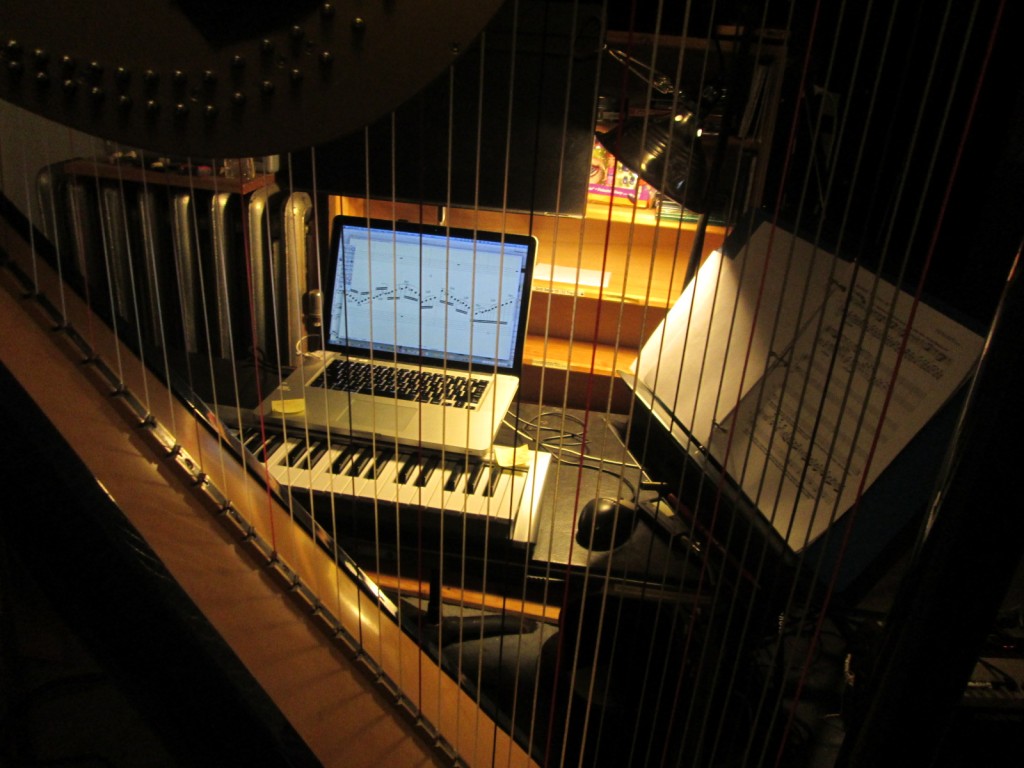
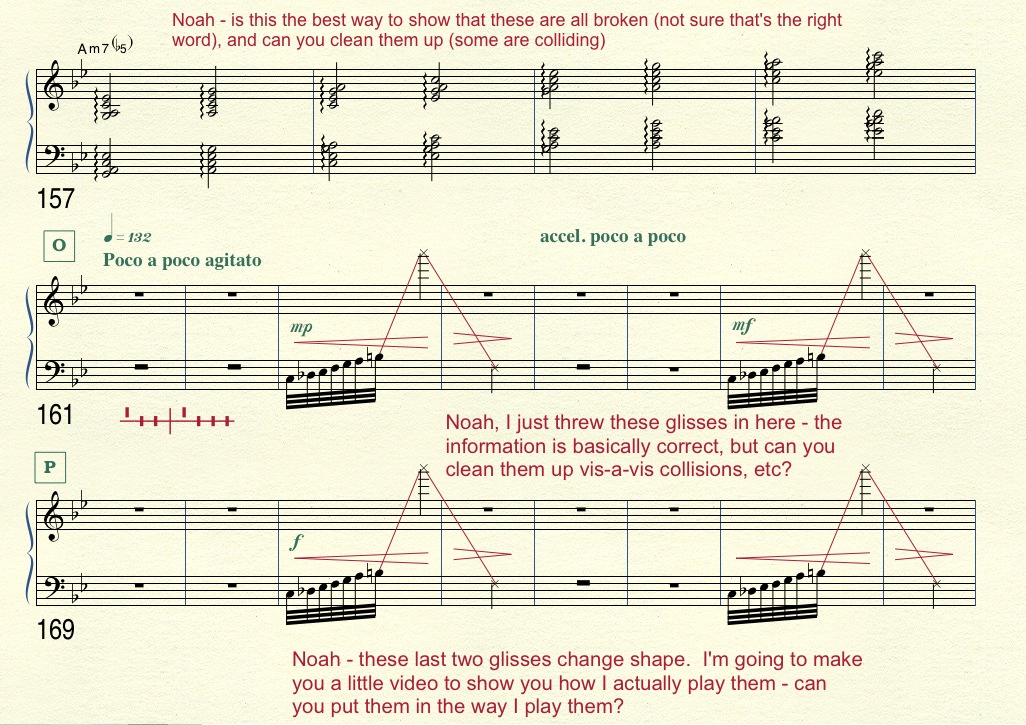
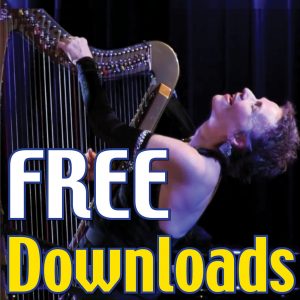
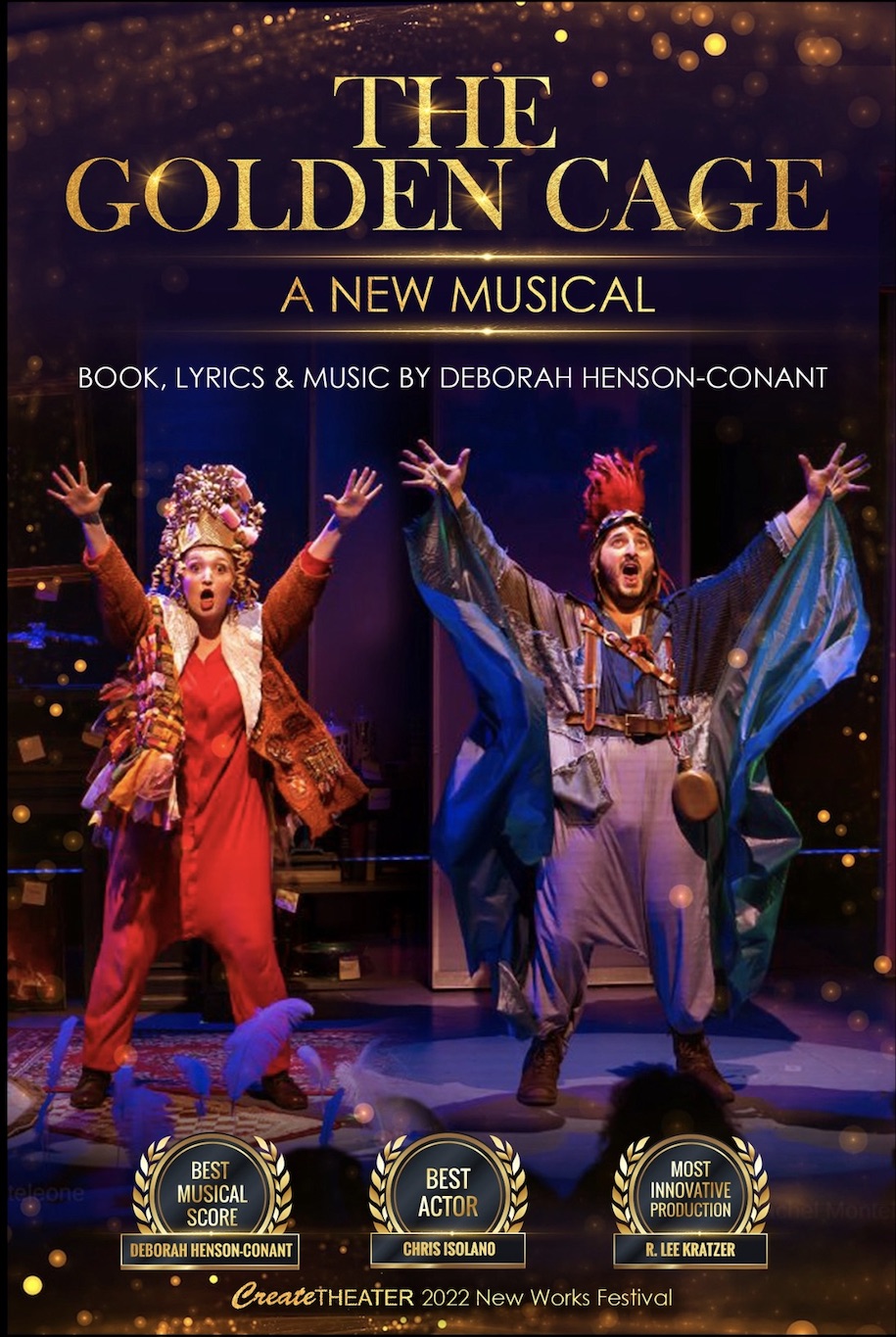
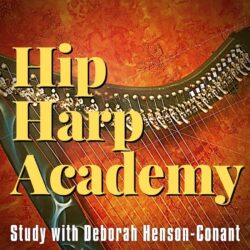

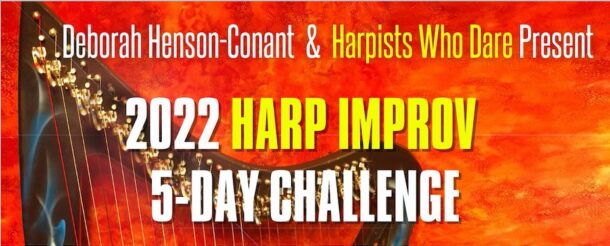
Hola Deborah, me gustaría comprar las partituras y partichelas para tocar con orquesta, de soñando en español, como debo hacer? Saludos, Natalia desde argentina!
Hello Deborah, I would like to buy the scores and partichelas to play with orchestra, of “Soñando en español”, how should I do? Greetings, Natalia from Argentina!
That’s great, Natalia! Email my office at info@hipharp.com and we’ll get that started.